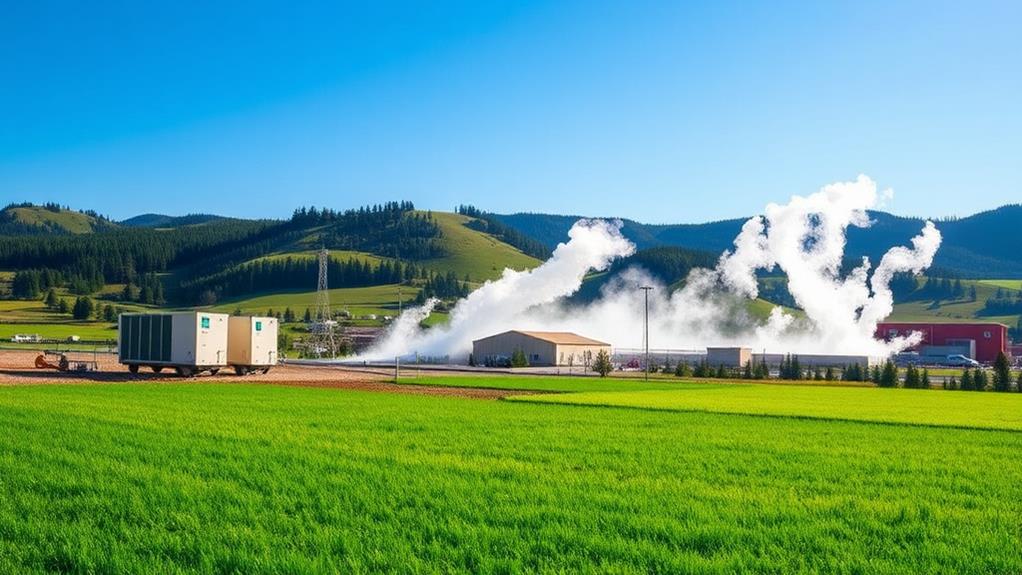Photovoltaic performance and price tradeoffs are driven by several vital factors, including module efficiency, material quality, installation techniques, and long-term durability. For instance, high-efficiency modules, which reach benchmarks of 29%, maximize energy output per unit area, thereby reducing the levelized cost of energy (LCOE) despite potentially higher initial costs. Additionally, robust materials and advanced manufacturing processes enhance longevity, maintaining low degradation rates of ideally 0.2% annually, essential for cost-effective solar solutions. Installation methods also affect overall expenses, impacting both initial investment and long-term financial returns. Understanding these dynamics is important for optimizing your photovoltaic investments effectively.
Key Takeaways
- Module efficiency impacts both energy output and levelized cost of energy (LCOE), influencing overall system economics.
- Higher efficiency modules may have increased upfront costs but can lead to significant long-term savings.
- Material quality and durability directly affect degradation rates, influencing performance longevity and maintenance costs.
- Installation techniques and balance of system costs vary, impacting the overall financial viability of PV projects.
- Technological advancements continuously drive improvements in efficiency while reducing costs, enhancing performance and economic feasibility.
Understanding Photovoltaic Efficiency
When it comes to photovoltaic (PV) efficiency, understanding key metrics is essential for anyone looking to harness solar energy effectively. The benchmark efficiency for PV modules currently stands at 29%, which greatly influences the overall economics and performance of solar energy systems. Higher efficiency modules maximize energy output per unit area, thereby lowering the levelized cost of energy (LCOE), a critical factor for space-constrained installations. Additionally, you should consider degradation rates; a low degradation rate of 0.2% per year is ideal for long-term economic viability. As technology advances, continuous improvements in PV efficiency are crucial to meet ambitious LCOE reduction targets. However, balancing efficiency with cost and performance often involves trade-offs that must be carefully evaluated.
Key Factors Influencing Costs

Numerous factors considerably influence the costs associated with photovoltaic (PV) systems. One key element is the efficiency of the modules you select, as higher efficiency, like the 29% benchmark, directly impacts the levelized cost of energy (LCOE). Installation expenses can greatly vary, especially with larger format modules (182 mm and 210 mm) that support higher capacity outputs, enabling economies of scale. Additionally, consider the system's lifetime; a PV system lasting 50 years with a 0.2% degradation rate greatly cuts long-term costs. Shifting to hybrid mini-grids can also lower operating expenses, particularly in developing regions. Finally, using direct burial cables reduces balance of system (BoS) costs, streamlining installation and enhancing overall project cost-effectiveness, which is crucial for module manufacturers and investors alike.
Material Quality and Performance
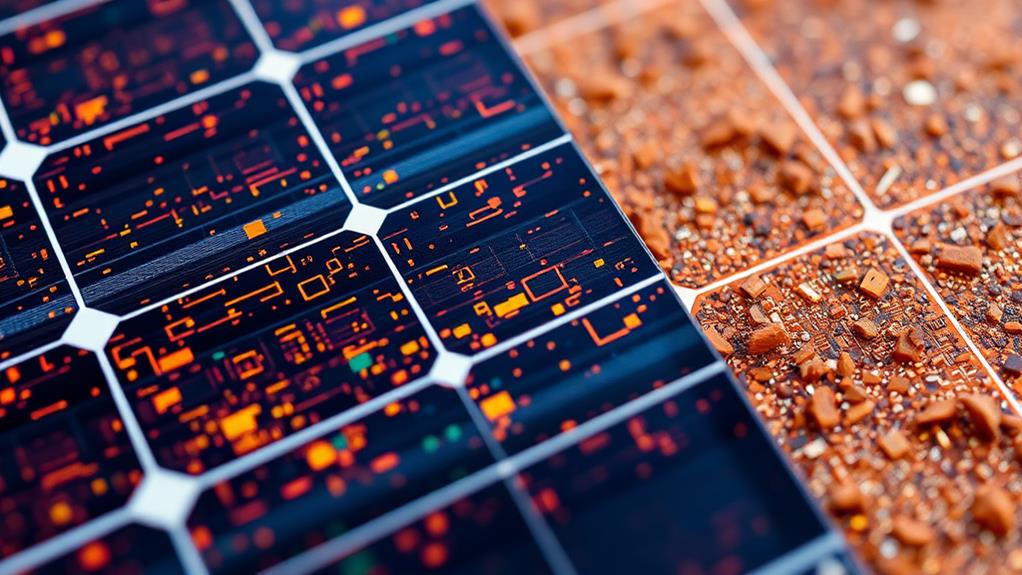
When considering the impact of material quality on photovoltaic (PV) performance, you'll find that module efficiency is closely tied to the choice of materials, with high-efficiency modules reaching up to 29% efficiency. Durability also plays a critical role, as using robust materials can greatly reduce degradation rates, ideally maintaining an ideal rate of 0.2% per year to guarantee economic viability over time. Additionally, the manufacturing process influences material integrity, where innovations in construction, such as dual-layer EPR/CPE in PV wires, enhance resilience against environmental factors, ultimately contributing to improved overall system performance and longevity.
Module Efficiency Impact
Optimizing module efficiency is essential for maximizing the performance of photovoltaic systems. High-efficiency modules, particularly those reaching 29% efficiency, markedly lower the levelized cost of energy (LCOE) by improving overall system output and reducing the number of modules required for a specific capacity. Utilizing advanced materials, like innovative silicon and specialized coatings, enhances light absorption, minimizes energy losses, and ultimately boosts energy production. Moreover, maintaining a low degradation rate, ideally around 0.2% annually, is critical for ensuring long-term performance and economic viability. While investing in high-efficiency modules may require higher initial costs, the long-term savings from decreased energy expenses and improved performance can justify these upfront investments, making understanding these trade-offs essential for informed decision-making.
Material Durability Considerations
Material durability plays an essential role in the long-term success of photovoltaic systems, as the right choice of materials can considerably influence both performance and longevity. High-quality materials effectively reduce degradation rates; ideal rates around 0.2% per year can contribute to a projected 50-year module lifespan. The choice of encapsulants and back sheets directly impacts the efficiency and costs of solar modules. For instance, dual-layer constructions like EPR/CPE offer superior resistance compared to single-pass constructions.
| Material Type | Durability Rating | Cost Impact |
|---|---|---|
| Single-layer | Moderate | Lower initial |
| Dual-layer | High | Higher initial |
| Thinner glass | Low | Variable |
Effective durability management is essential for maximizing performance and minimizing economic impacts.
Manufacturing Process Influence
Understanding how the manufacturing process influences the quality and performance of photovoltaic (PV) modules is essential for anyone considering solar energy solutions. The purity of raw materials, particularly silicon, is vital; higher purity leads to better efficiency and longevity. Advanced techniques like passivated emitter and rear cell (PERC) technology can boost energy conversion efficiencies to 22% or more. Furthermore, utilizing larger wafers, such as 182 mm and 210 mm, enhances module capacity and reduces the levelized cost of energy (LCOE). Innovations like bifacial designs capture sunlight on both sides, improving energy yield by up to 30%. Finally, rigorous quality control in manufacturing processes considerably lowers degradation rates, ensuring a longer operational lifespan and enhanced return on investment for solar power users.
Installation Techniques and Expenses

Installation techniques play a crucial role in determining the overall expenses associated with photovoltaic (PV) systems. Using direct burial-rated PV wire or USE-2 cables can reduce costs considerably, as it eliminates the need for additional conduit materials and labor. However, opting for large-format modules might increase installation complexity and labor expenses, necessitating specialized handling equipment. Advanced installation practices, such as optimizing racking systems, can enhance energy density and lower the levelized cost of energy (LCOE), despite higher initial costs. It's important to adhere to local codes and standards to guarantee long-term performance and compliance, ultimately reducing future maintenance expenses. Additionally, the balance of system (BOS) costs varies widely based on chosen installation methods and materials, emphasizing the necessity for cost-effective design choices.
Long-term Durability Considerations

When considering long-term durability in photovoltaic systems, you'll need to pay close attention to module degradation rates, which directly impact overall costs and performance. With an ideal degradation rate capped at 0.2% per year, any increase, such as 2%, can dramatically affect your return on investment due to the necessity of replacement and maintenance strategies. Additionally, it is crucial to implement robust testing and validation methods that go beyond standard certifications to guarantee that your modules can withstand environmental stress factors, thereby ensuring longevity and reliability over their expected 50-year lifespan.
Module Degradation Rates
Typically, module degradation rates play a significant role in determining the long-term durability of photovoltaic systems. An ideal degradation rate of around 0.2% per year is perfect to guarantee a 50-year lifespan, which is vital for maintaining economic viability. In contrast, a degradation rate of 2% per year could severely impact pricing, forcing you to rely on zero-cost modules to meet levelized cost of energy (LCOE) goals if the system is only expected to last a decade. Longer lifetimes not only correlate with better returns on investment but also require effective degradation management strategies to prolong module longevity. High reliability in PV modules enhances consumer confidence, minimizing long-term maintenance and replacement costs while securing sustained performance throughout the system's operational life.
Environmental Stress Factors
Understanding module degradation rates is just one part of ensuring the long-term durability of photovoltaic systems. Environmental stress factors can greatly impact this durability, accelerating degradation and increasing lifecycle costs. To safeguard your investment, consider the following:
- Extreme temperatures can weaken materials.
- High humidity promotes corrosion and moisture ingress.
- UV exposure deteriorates protective coatings.
- Mechanical stress from severe weather can compromise structural integrity.
Thinner glass and frames in large-format modules raise concerns about vulnerability to these stressors. Regular maintenance and monitoring are essential to identifying potential failures before they escalate, preserving efficiency and minimizing operational costs. Adhering to industry standards and beyond-certification testing is vital for ensuring your PV modules can withstand the environmental challenges they will face throughout their operational life.
Testing and Validation Methods
Regularly evaluating the long-term durability of photovoltaic (PV) modules is essential for ensuring their reliable performance over decades. The testing methods employed must focus on degradation rates, which ideally should not exceed 0.2% per year. Additionally, beyond-certification testing validates long-term performance under environmental stressors, while accelerated life testing simulates years of wear in a compressed timeframe.
| Testing Method | Purpose |
|---|---|
| Long-term Durability Testing | Assess performance over 25-30 years |
| Beyond-Certification Testing | Validate under real-world environmental conditions |
| Accelerated Life Testing | Identify failure modes before market deployment |
| Field Data Monitoring | Adjust designs based on performance insights |
Implementing robust quality assurance protocols during manufacturing is vital for minimizing defects and ensuring high-performance standards in PV module production.
Economic Viability of Solar Systems
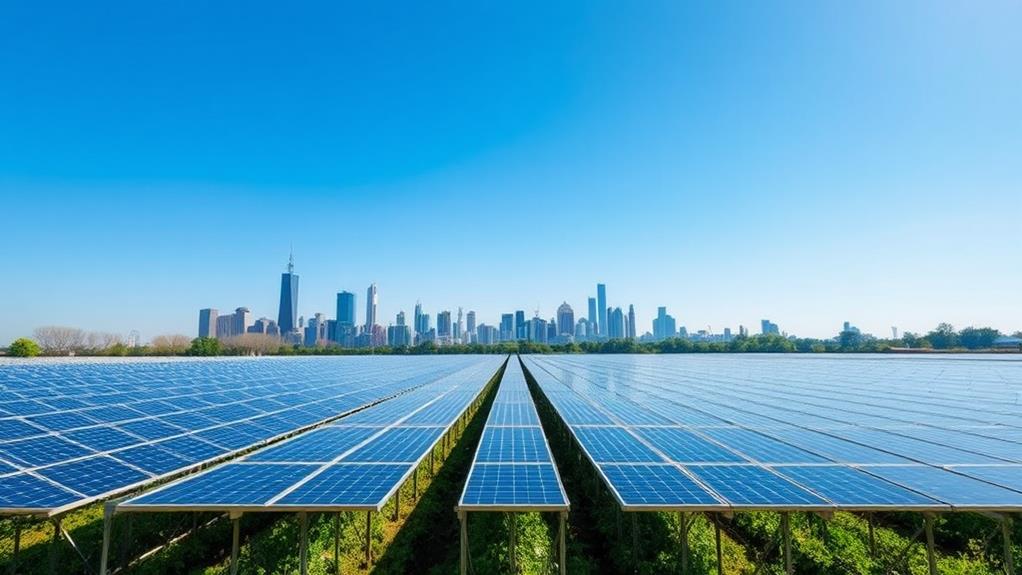
In recent years, the economic viability of solar systems has dramatically improved, driven by notable reductions in the levelized cost of electricity (LCOE). A decrease of 40%-50% from 2015 to 2020, aided by initiatives like the SunShot Initiative, has made solar more accessible. High-efficiency solar modules, boasting efficiencies of up to 29%, contribute notably to this lower LCOE, enhancing returns on investment. Additionally, energy storage systems provide essential flexibility, enabling you to mitigate peak electricity costs effectively. Consider the following advantages:
- Long-term savings on energy bills
- Increased energy independence
- Enhanced property value
- Contribution to a sustainable future
Reliability, with a target lifespan of 50 years and minimal degradation, further solidifies the economic case for solar systems, ensuring consumer confidence in this transformative technology.
Balancing Performance and Cost
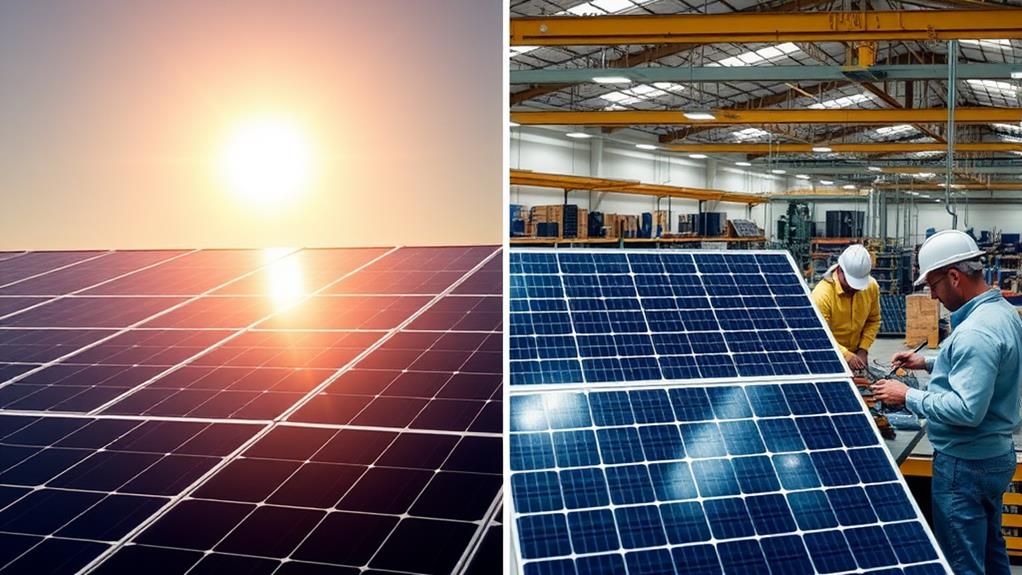
Balancing performance and cost in photovoltaic systems is essential for maximizing long-term benefits. The tradeoff often revolves around module efficiency, with 29% efficiency modules providing a benchmark that helps achieve lower levelized cost of energy (LCOE) goals. While high-performance designs may come with higher upfront costs due to advanced materials, they can greatly reduce energy expenses over time. Conversely, cost-effective designs might limit scalability and future performance potential. Additionally, degradation rates ideally should be around 0.2% per year for high reliability, as higher degradation leads to increased lifetime costs and diminished returns on investment. Continuous technological advancements are vital for driving cost reductions while maintaining or enhancing performance, emphasizing the need for collaboration among industry stakeholders.
Future Trends in Photovoltaics
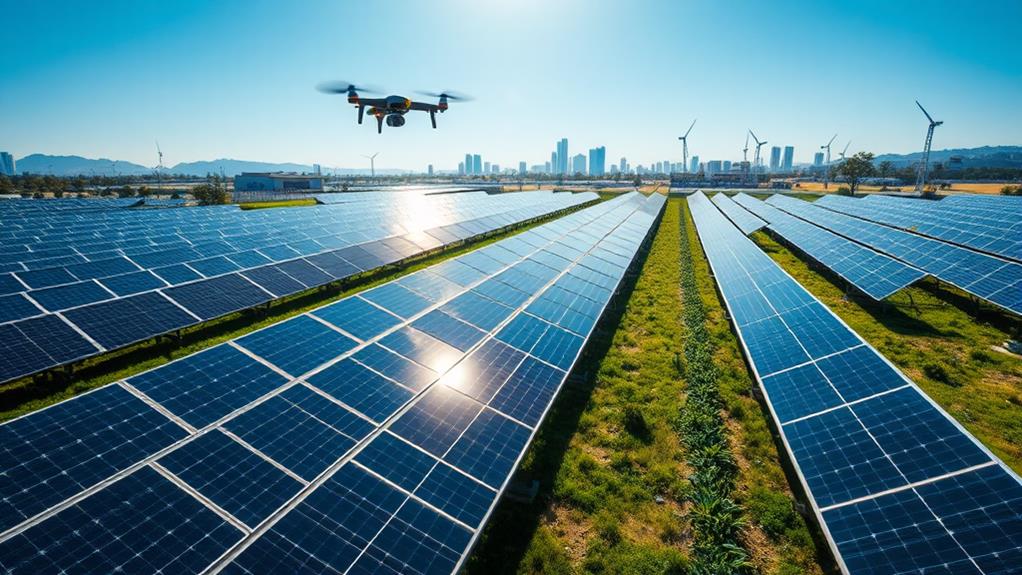
As the photovoltaic industry evolves, future trends reveal a clear shift toward large-format modules, which are expected to dominate 90% of the utility market by 2025. This change is poised to enhance energy density and reduce the levelized cost of energy (LCOE) through economies of scale.
Consider the implications for our energy future:
- Higher efficiency modules, targeting 29% efficiency, will drive performance.
- Battery storage integration will support nearly zero-carbon buildings with 60% renewable penetration.
- Economic assessments will shape policy, aligning technology with sustainable energy goals.
- By 2040, renewable energy is projected to account for 56% of global electricity generation.
These trends signify a powerful movement toward maximizing solar energy's potential, enabling greater energy independence and freedom.
Frequently Asked Questions
What Are Some of the Trade Offs of Using Solar Panels?
When considering solar panels, you'll face trade-offs like higher installation costs versus long-term savings, maintenance requirements, energy storage needs, and land use. Balancing these factors can empower your energy independence and sustainability journey.
What Are the Tradeoffs of Using Renewable Energy?
When you consider renewable energy, you're weighing economic implications against environmental impact. Technology advancements, policy incentives, and energy storage can boost grid integration, but installation costs and maintenance requirements can complicate your freedom to choose.
What Reduces the Performance of the Electrical Output of PV Panels?
Shading effects, temperature impact, dust accumulation, panel orientation, installation quality, and inverter efficiency all reduce your PV panels' performance. You've gotta keep them clean, well-placed, and guarantee proper installation for peak energy output.
What Factors Affect Solar PV System Efficiency?
Your solar PV system's efficiency hinges on panel orientation, temperature effects, shading impact, inverter efficiency, and the quality of installation. Embracing advanced solar technology can help you maximize performance and enjoy energy independence.

